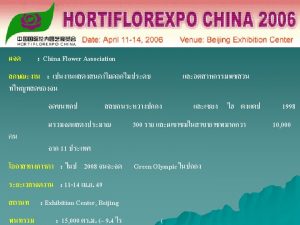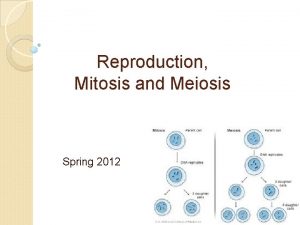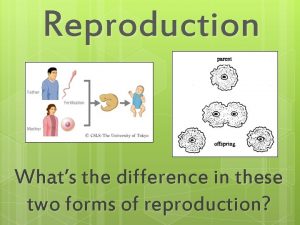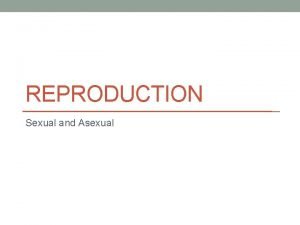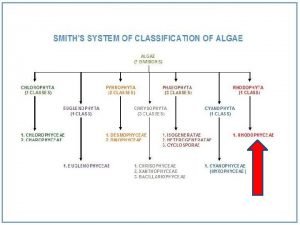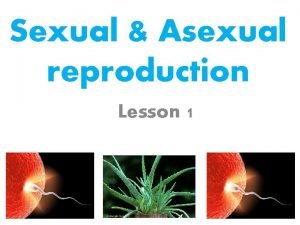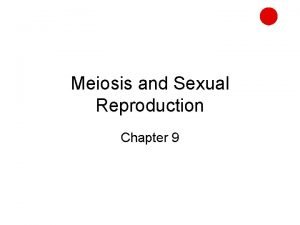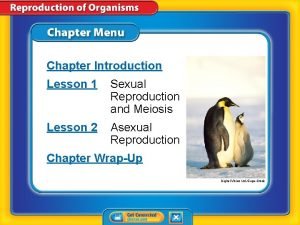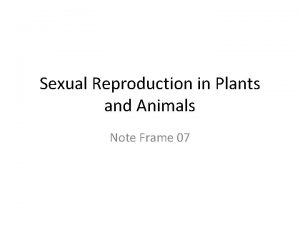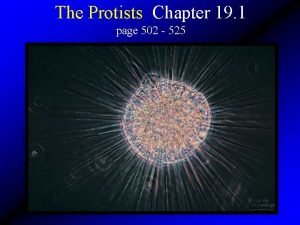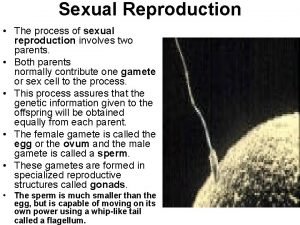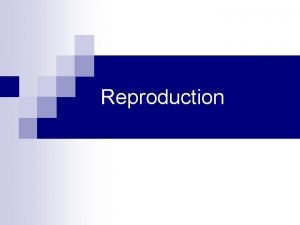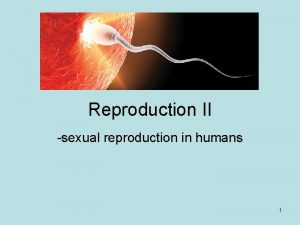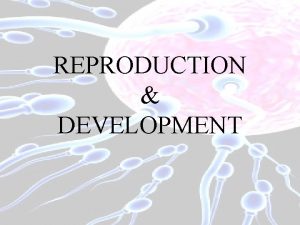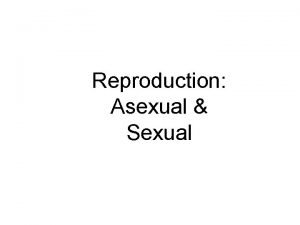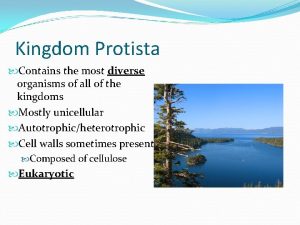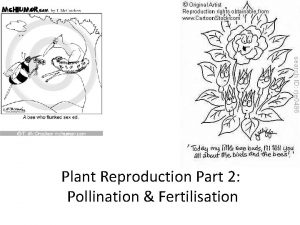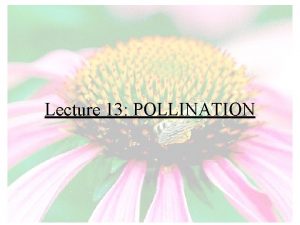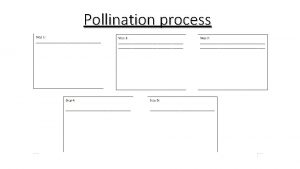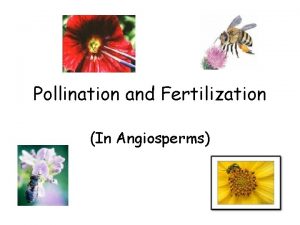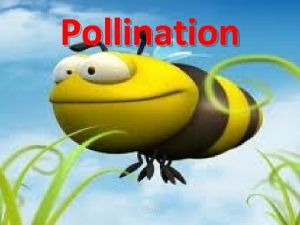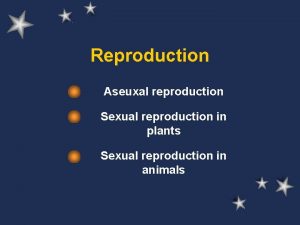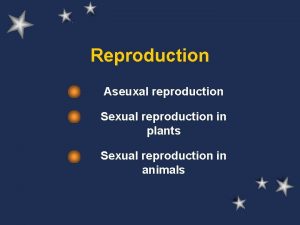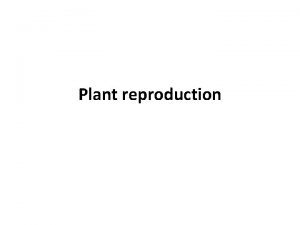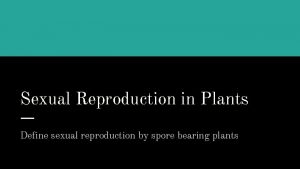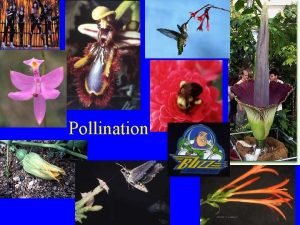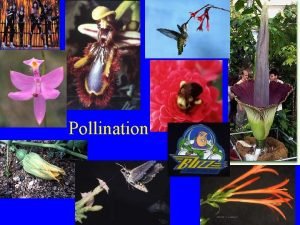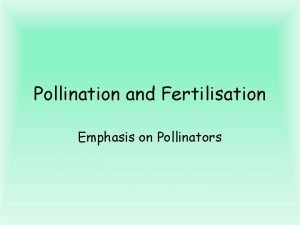Sexual Reproduction in Plants Sexual Reproduction includes Pollination























- Slides: 23

Sexual Reproduction in Plants

Sexual Reproduction includes: • Pollination • Fertilization • Seed Production • Sexual reproduction also known as seed reproduction because it involves using seeds to produce new plants.

Seeds • Seeds contain all the genetic characteristics of the parent plant • However, the characteristics of the plant grown from seeds may vary from parent plant.

Reasons for Seed Propagation Most Economical Most widely used method Allows a grower to produce a larger number of plants.

Parts of the Flower

Parts of the Flower • Stamen- Male reproductive part of the flower v. Anther- produces the pollen grains v. Filament- supports the anther. • Pistil – Female reproductive part of the flower v. Stigma- Sticky surface to capture the pollen v. Style- Tube that connects the stigma to the ovary v. Ovary-contains the ovules.

Pollination • When a flower opens, the stamens mature and become fully developed. • The anthers on the stamen then release hundreds of pollen grains • Pollen grains are the male sex cell • Each pollen grain contains genetic characteristics of the plant.

Pollination • Flower ovary contains one or more ovules, which are the female sex cells • Each ovule contains genetic information of the plant as well. • Pollination occurs when the pollen grains come into contact with the sticky surface of the stigma.

Types of Pollination • Self Pollination: – The transfer of pollen from the anther of a flower to the stigma of the same flower. , or to a different flower on the same plant. • Cross Pollination – The transfer of pollen from the anther of a flower to the stigma of a flower on a different plant.

Self Pollination • More Effective • Almost guarantees pollination • Isn't’ dependable on outside variables for pollination

Cross Pollination • Increases genetic variability • Accomplished through – Wind – Bees – Birds

Methods of Pollen Distribution • Wind – Pollen grains are carried by wind from one flower to another • Animals – Birds ( Hummingbirds) – Insects ( moths, butterflies, bees, flies) – Mammals ( bats)

Flowers of wind pollinated plants are: • • • Small Greenish or brown No fragrance Small or no petals No Nectar Examples Include Grasses, wheat and cattails

Flowers that are pollinated by hummingbirds and butterflies are: • Tube shaped • Fragrant fro butterflies, no fragrance for hummingbirds • Brightly colored, usually red attracts hummingbirds • Produce nectar which is an attractive snack.

Flowers that are pollinated by flies • Brown and dark colored • Have foul odor

Flowers that are pollinated by bees are • Fragrant (nectar as a “reward) • Brightly colored with nectar guides visibly only with UV light that bees can see, which directs bees to the center of the flower • Sweet Fragrance • Produce Nectar

Flowers that are pollinated by bats and moths • Tube Shaped • Fragrant • White or yellow which can be seen easily at night • Sometimes only open at night

Fertilization • Cells of many plant flowers are diploid ( two sets of chromosomes) Represented by 2 n • Some of these cells undergo a process of cell division called meiosis. This process causes the chromosomes number to be halved and the result are “daughter cells”. • The daughter cells are haploid (one set of chromosomes) represented by 1 n

Fertilization • The daughter cells undergo another process of cell division called mitosis, which produce more haploid egg or sperm cells. • When these cells come together (fertilization) they form the zygote which is then a diploid


Process of fertilization • After the pollen grain lands on the stigma, it develops a pollen tube which travels down the style. • The pollen grain releases a sperm cell, in some cases 2 sperm cells • The sperm travel down the pollen tube and reach the ovary, then enter the ovule • If there are two sperm cells, one fertilizes the egg while the other fuses with another cell and produces the endosperm. This is called double fertilization.

Development of Seed • The diploid zygote forms the embryo. These cells will later divide and form parts of the seed • Cells in the outer layer of the ovule harden and become the seed coat. • The endosperm grows and becomes the food source for the growing seed

3 essential parts of the seed. • Embryo- Embryonic Root (Radical) • Endosperm/Cotyledon- Food Reserve • Seed Coat
 Venn diagram asexual vs sexual reproduction
Venn diagram asexual vs sexual reproduction Binary fission in bacteria
Binary fission in bacteria Asexualk
Asexualk A sexual reproduction in plants
A sexual reproduction in plants Mitotic meaning
Mitotic meaning What is reproduction
What is reproduction Asexual or sexual reproduction
Asexual or sexual reproduction Red alga
Red alga Significance of sexual reproduction
Significance of sexual reproduction Asexual example
Asexual example Meiosis
Meiosis Connecting the concepts sexual reproduction
Connecting the concepts sexual reproduction Asexual and sexual reproduction difference
Asexual and sexual reproduction difference Sexual reproduction in paramecia is called _____.
Sexual reproduction in paramecia is called _____. Sexual reproduction stages
Sexual reproduction stages Are chickens asexual animals
Are chickens asexual animals Sexual reproduction in humans
Sexual reproduction in humans Chapter 10 sexual reproduction and genetics
Chapter 10 sexual reproduction and genetics Sexual reproduction in human
Sexual reproduction in human Asexual or sexual reproduction
Asexual or sexual reproduction Advantages of genetic diversity
Advantages of genetic diversity Asexual reproduction cell division
Asexual reproduction cell division Phases of meiosis
Phases of meiosis Most diverse kingdom
Most diverse kingdom



